Delhi also known as the heart of India is famous for its bustling streets, historical landmarks, vibrant culture, food and many more. But Delhi is also known for the worst air quality in the world. Delhi air quality index AQI is affecting the life expectancy of every Dilliwala. Every winter morning, Delhiites wake up with new alarming pollution levels that break previous records and set new positions. Do you think Delhi will go through the same air pollution problems as in previous years? Will Delhiites’ life expectancy drop again this year? Does air pollution again turn into a life-threatening issue in Delhi?
Shrinking your life expectancy with deteriorating Delhi air quality index AQI:
Every year, air quality in Delhi is affecting the health of thousands of people. Waking up with a coughing throat, frequent headaches, throat infections and more asthma conditions are increasing. A news article by BBC highlights that air pollution is decreasing life expectancy by around 10 years. In this blog, learn how the Delhi air quality index has changed over the past three years and learn about the government’s efforts to manage air pollution in the city.
What is the Delhi air quality index AQI?
The Air Quality Index is a scale to measure harmful pollutants in the environment to know the level. Particular matters 2.5 and 10 are the major pollutants taking several lives every year.
Delhi’s air quality index drastically deteriorates in the unhealthy, severe or hazardous category from October to February. In between Monsoon as from June to September, Delhi AQI remains in Good, moderate and satisfactory category. But every year, these five months break every previous record in air pollution levels. This is also known as winter pollution which gives a new name to Delhi every year such as Gas Chamber, Smog Capital, “Living Narak” (Hell) and many more.
What are the Delhi air pollution sources?
Many factors are responsible for affecting the air quality index of Delhi. Over 33 million people are residing in Delhi including a total registered vehicles of 19 million by 2021. It causes emissions from different sources. Several factors including road dust, vehicle emission, construction, open waste burning emission, stubble burning and many other factors result in air pollution in Delhi. With it, weather conditions in Delhi impact the air quality index in Delhi.
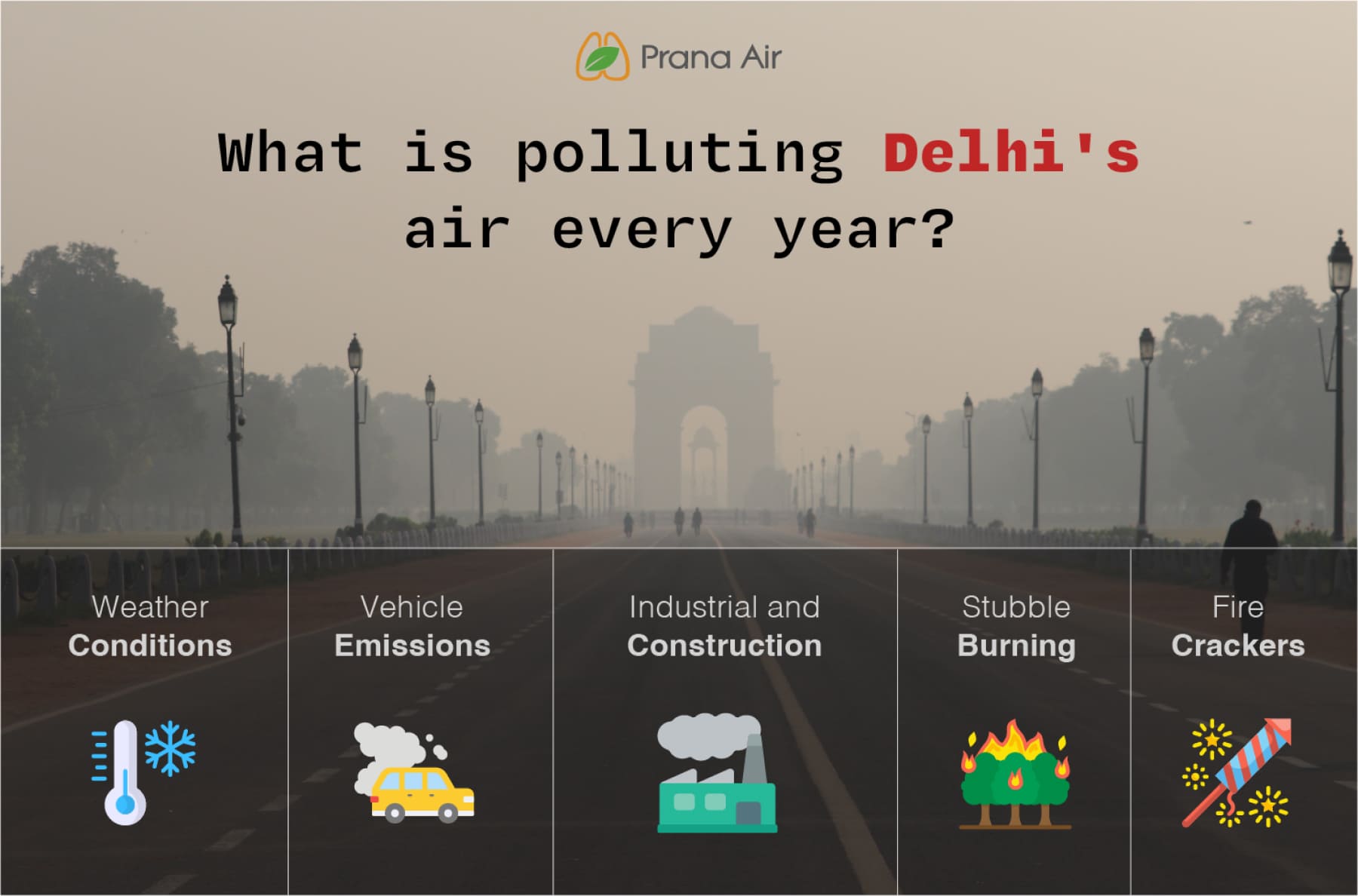
Weather conditions in Delhi:
Delhi’s air quality index AQI is as peaks in winter and lowest in monsoon. From late September to early February temperature drops below to 10˚C. Winter pollution affects the entire air pollution condition in Delhi. Low temperature traps more pollutants in the environment. Moreover, various activities take place during winter that lead to higher emissions. It is also known as thermal inversion which results in winter air pollution in Delhi.
Vehicle emission:
Millions of vehicles on the road result in traffic congestion and more jams during peak hours of the day. It results in emissions due to engine exhausts and emits various pollutants in the air. Vehicle emission releases PM2.5, PM10, and various harmful gases that increase levels of AQI in New Delhi.
Industrial and construction:
Various construction activities and industries emit pollutants in the environment. Construction sites in Delhi are major sources of PM2.5, PM10 and other pollutants. Industrialization and everyday development increase emissions due to demolition and other activities.
Stubble burning and firecrackers:
Delhi air quality index AQI is highest every year during winter. Another air pollution source in Delhi is stubble burning and firecrackers. Stubble burning in nearby states and locations of Delhi results in a smog layer. With it, celebrations with firecrackers emit various pollutants in the air.
Let us know the Delhi air quality index by month:
For most recently let’s take the Delhi Air Quality Index 2024 and the last two months’ conditions from the past year as AQI of New Delhi 2023. Air quality in Delhi also depends on the weather conditions and different activities going on in the city. Here is the data of air quality index by every month:
Delhi AQI By Month: The Clear Trend
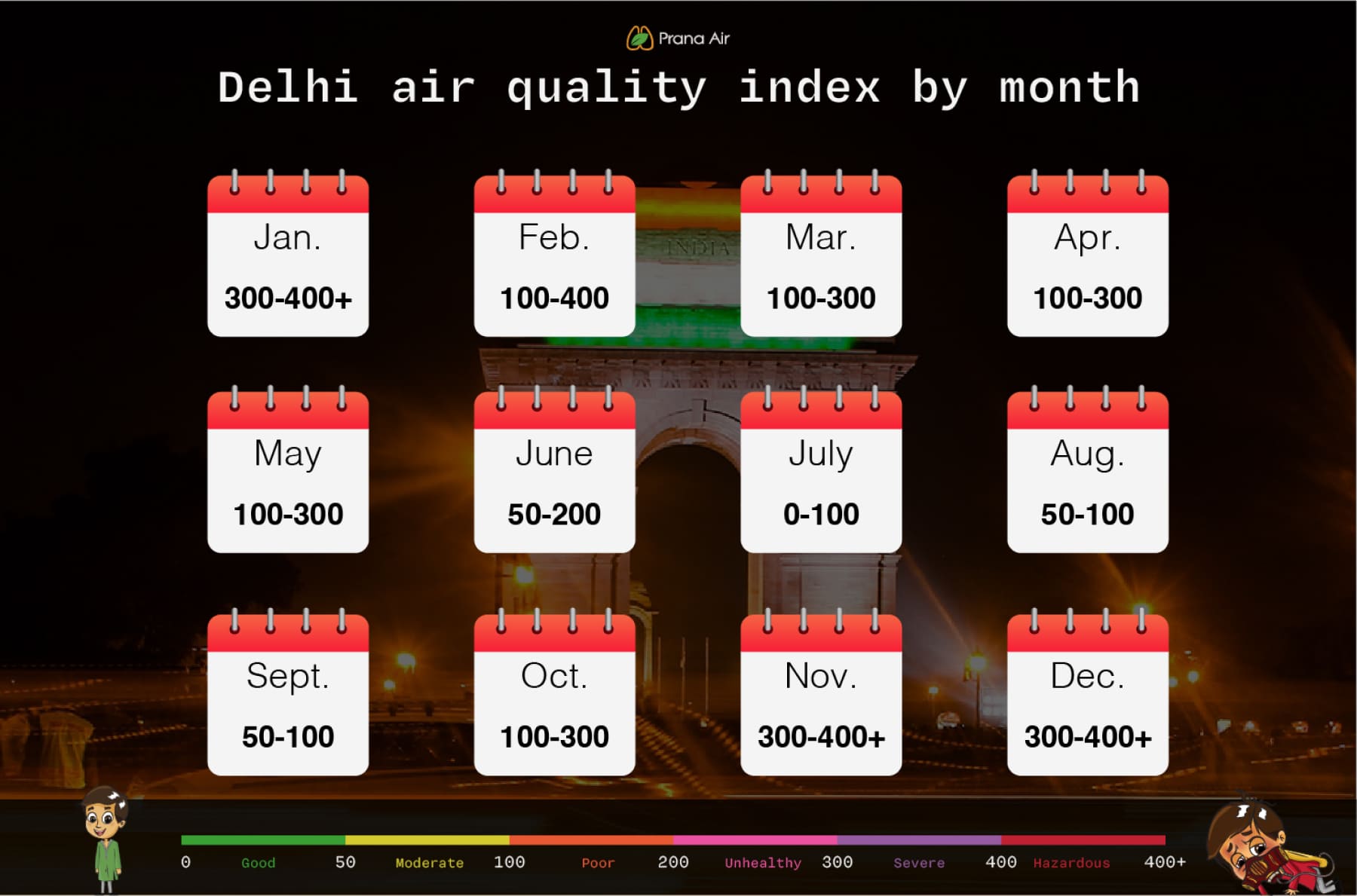
- January: Unhealthy to Severe to Hazardous
- February: Poor to Unhealthy to Severe
- March-May: Poor to Unhealthy
- June-September: Poor to Moderate
- October-December: Poor to Unhealthy to Severe to Hazardous
These months reflect Delhi’s ongoing struggle with air pollution, particularly as winter approaches.
Is the history of the Delhi Air Quality Index AQI repeating itself?
Do you also think that is Delhi air quality index today is similar to the last year on the same day? Let us know whether the AQI history in Delhi is repeating itself or not:
Delhi Air Quality Index 2024
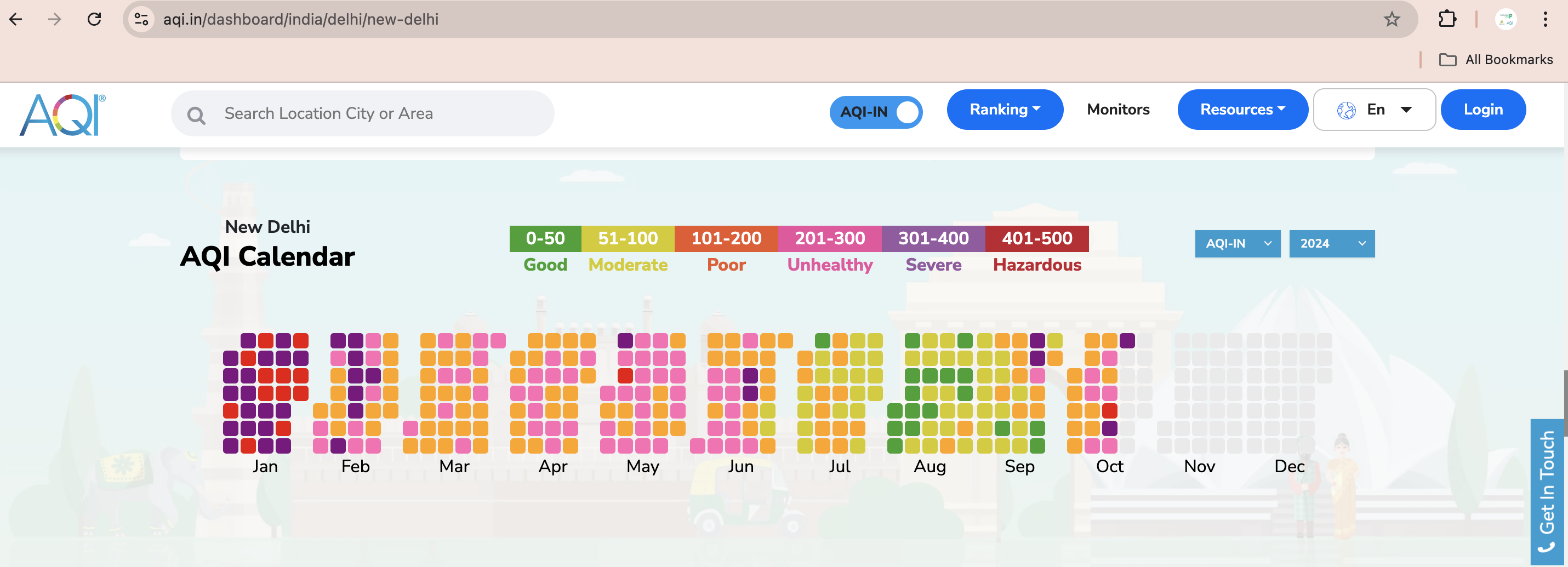
New Year Same Conditions?
January and February both months started with hazardous, severe and unhealthy air quality. Coughing the pollution for more than a month, a relief comes in life with air quality in the “Poor” category.
Was improvement real?
Delhi saw a little improvement in air quality from March to May with “Moderate to Unhealthy” days. Again May with mostly unhealthy air pollution days.
Can monsoon improve Delhi Air Quality?
AQI in Delhi during June remains in the “Unhealthy” and “Poor” Category. Favourable weather conditions bring a notable trend in Delhi AQI as air quality between the “Moderate” and “Good” categories. August becomes the most clean air month of the year 2024.
Cannot remain the same:
Air pollution conditions started worsening again at the end of September. Winters started approaching in October and in just a blink AQI spikes to “Severe” and “Hazardous” Categories in 17 days.
The remaining two months!
What should Delhiites expect from the Air Quality Index of Delhi? Will we see the same air quality similar to the AQI level in 2023 and 2022? Or the timely action plan can bring the change in the air quality trends of the last two months. Stay tuned to learn more about the Delhi air quality index 2024.
Delhi Air Quality Index 2023
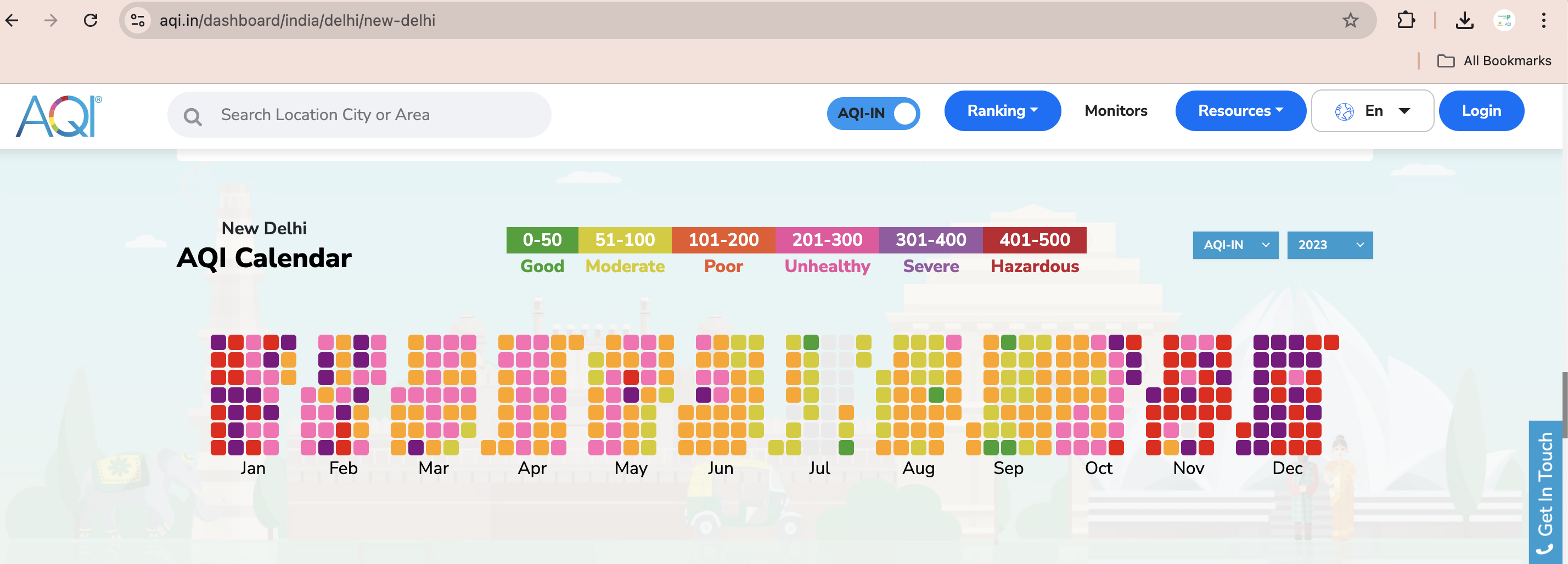
A difficult start:
Delhi Air Quality Index 2023 started with “Unhealthy” and “Severe” AQI levels from January to March.
Improvement in Air for Delhiites:
Air Index in Delhi sees slight improvements from April to June as AQI at “Moderate” levels. The monsoon from July to September cleared some pollutants from Delhi Air. It helped Delhi People to enjoy some “Good” air quality days.
Again choking lungs:
From October onwards, Delhi’s air index surged again because of incoming winter and various emissions. It makes November and December severe polluted months in 2023 as the air index Delhi spikes to “Severe” and “Hazardous”.
Delhi Air Quality Index 2022
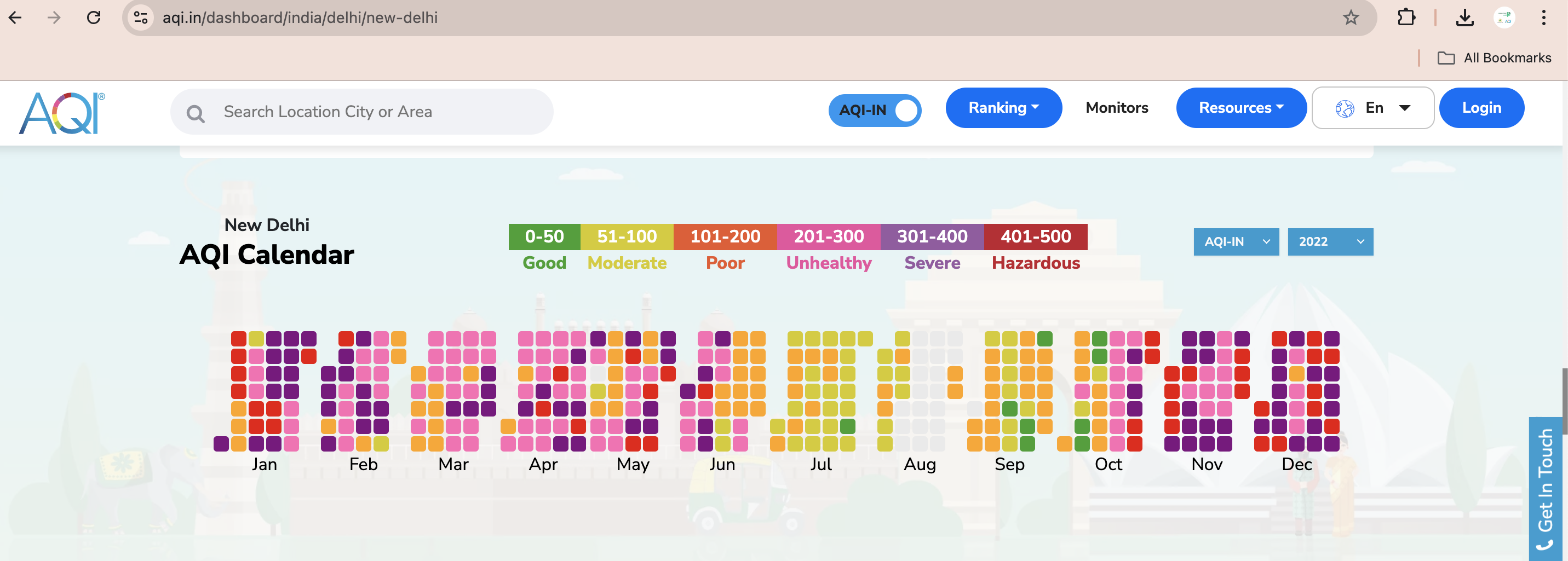
2022 Begins with consistent pollution levels:
The year started with no such improvements in Delhi Air quality index in January and February as the city was covered in smog with Unhealthy to Severe levels.
A hope of clean air days:
Summer AQI levels dropped into the “Moderate” category and Delhiwalas breathed some good air from July to September. The monsoon season helped in providing relief but only for some days.
Again Slaps from severe pollution:
The starting days of October brought a hope of clean air with good AQI levels but the situation worsened in just a week. AQI spiked to the “Severe” category. The last two months have seen a majority spike in air pollution.
How Delhi is fighting with air pollution levels every year?
The severe air pollution crisis tackled with a series of plans and policies in Delhi. New episode of air pollution in Delhi resulting in new initiatives. The most prominent initiatives are the NCAP and GRAP. Let us know about plans and policies to tackle New Delhi air pollution levels every winter:
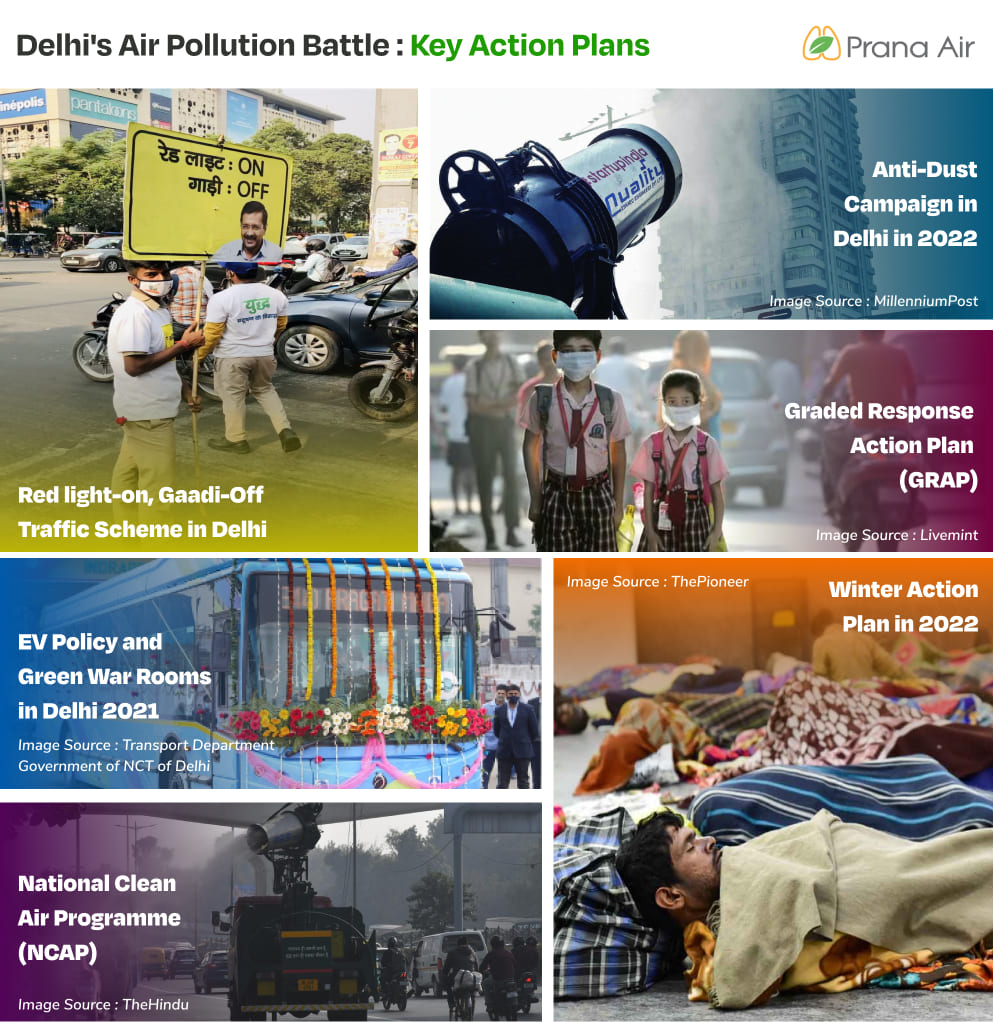
1. Graded Response Action Plan (GRAP)
GRAP was adopted in Delhi to combat air pollution conditions. Commission for Air Quality Management (CAQM) has implemented the GRAP in Delhi NCR. The plan has 4 stages to tackle the air pollution levels. Every year, the government revises the GRAP before implementing it as per the current pollution conditions and sources.
GRAP – Stage 1:
Moderate to Poor Air Quality involves a garbage burning ban, implementing measures for brick kiln industries, water sprinkling on roads, and enforcing cracker bans. Strict enforcement of PUC norms with zero tolerance for visible emissions.
GRAP – Stage 2:
Unhealthy AQI, Ban on of diesel, coal, and firewood use, parking fees will increase, and encouragement in public transport options.
GRAP – Stage 3:
Severe AQI, closure of brick kilns, stone crushers, and hot mix plants. Promotion of public transport, coal-based power plants operation ban.
GRAP – Stage 4:
Hazardous AQI, Ban on construction and demolition activities, restriction on heavy vehicles like trucks, and an odd-even plan for private vehicles. And Reductions in coal-based power generation.
2. National Clean Air Programme (NCAP)
The program was launched in January 2019. It was the first national-level strategy for air pollution in 122 cities. The plan involved promoting electric vehicles, renewable energy use, city-specific action plans and more focus on capacity building for air pollution monitoring and control.
3. ‘Red Light-On, Gaadi-Off’ & ‘Odd-Even’ Traffic Scheme in Delhi:
The Delhi government focused on vehicular emissions and thus implemented the Odd-Even Vehicle Rationing scheme in 2019 and 2020. It involved restrictions on private vehicles with odd and even-numbered plates to run on alternate days. The awareness plan launched and promoted by the Delhi Government as Red ligh-On, Gaadi-Off. It involves turning off the vehicle engine to reduce vehicle emission.
4. EV Policy and Green War Rooms in Delhi 2021:
The promotion for electric mobility increased in Delhi in 2021 as to the Delhi Electric Vehicle Policy. It aims to promote electric Vehicles (EVs) to reduce air pollution caused by vehicular emissions. The plan included incentives for vehicle purchasing, creating more EV charging points etc.
Delhi also launched Green War Rooms in 2021 which involved measuring real-time air quality across the city for quick responses during pollution spikes.
5. Anti-Dust Campaign in Delhi in 2022:
The Delhi Government launched the Anti Dust Campaign in 2022 to control dust pollution from various activities and sources. It involves using anti-smog guns and sprinklers to remove dust from the air. With it, strict monitoring restrictions are implemented for every construction site in Delhi.
6. Winter Action Plan in 2022:
The very same year, the government rolled out a Winter Action Plan of 15 points. It includes various measures to reduce emissions from different sources. Such as improving public transport, preventing stubble burning in nearby states, promoting EVs, and banning firecracker use in Delhi.
In the end, Delhi air quality index every year reaches dangerous levels. It’s high time for everyone to be aware and take action for the air quality around you. Your body will respond to the air you are breathing.







